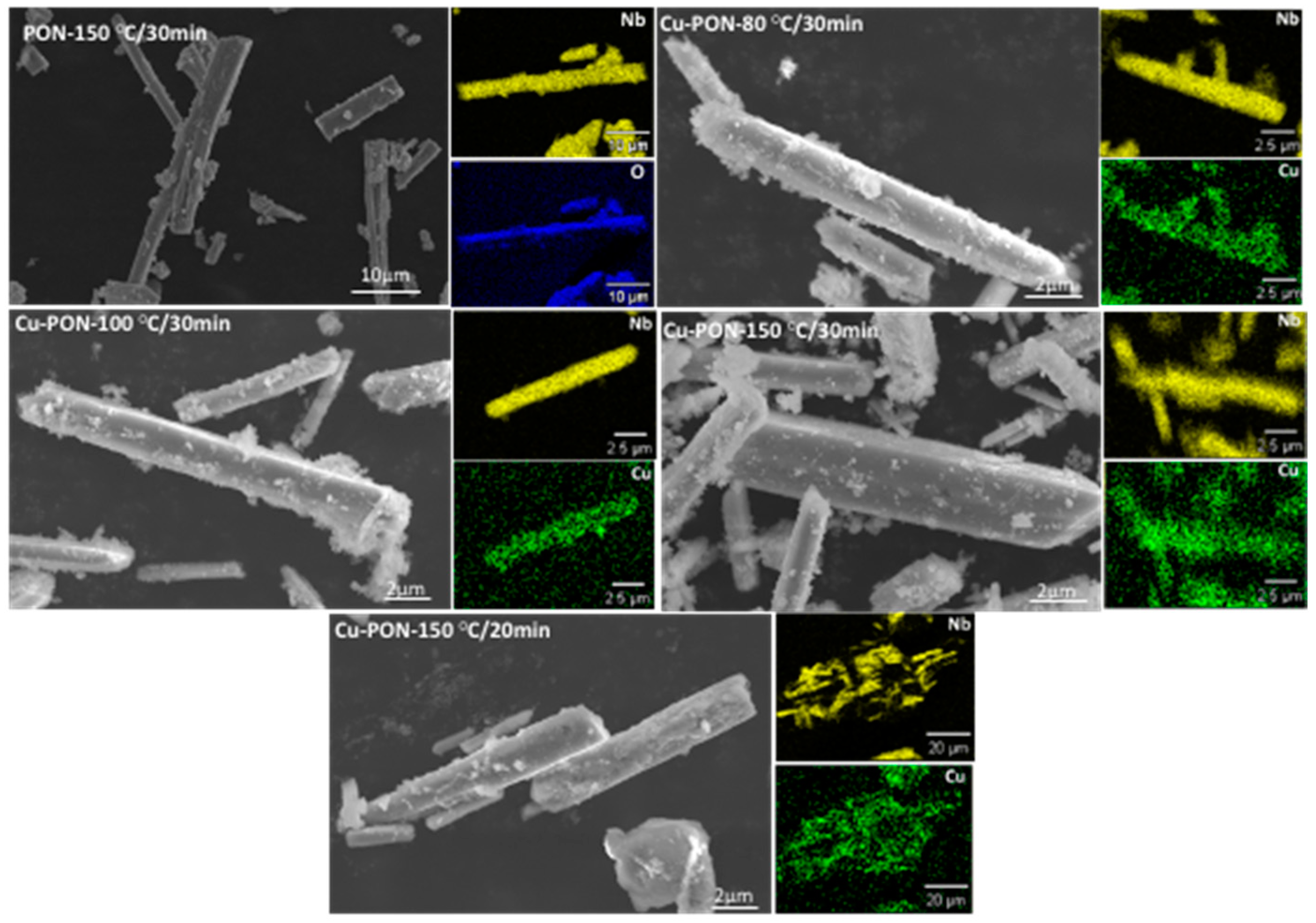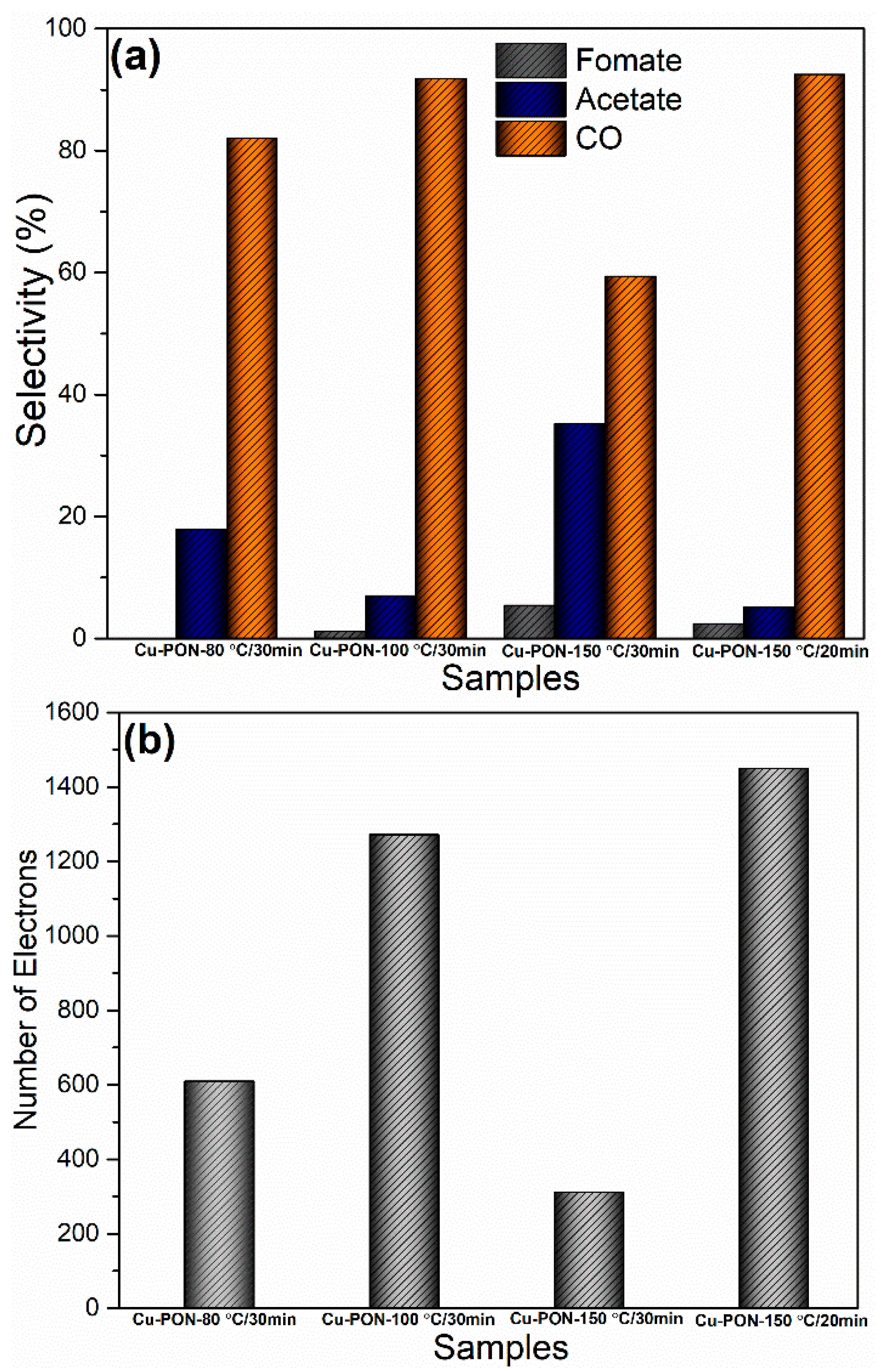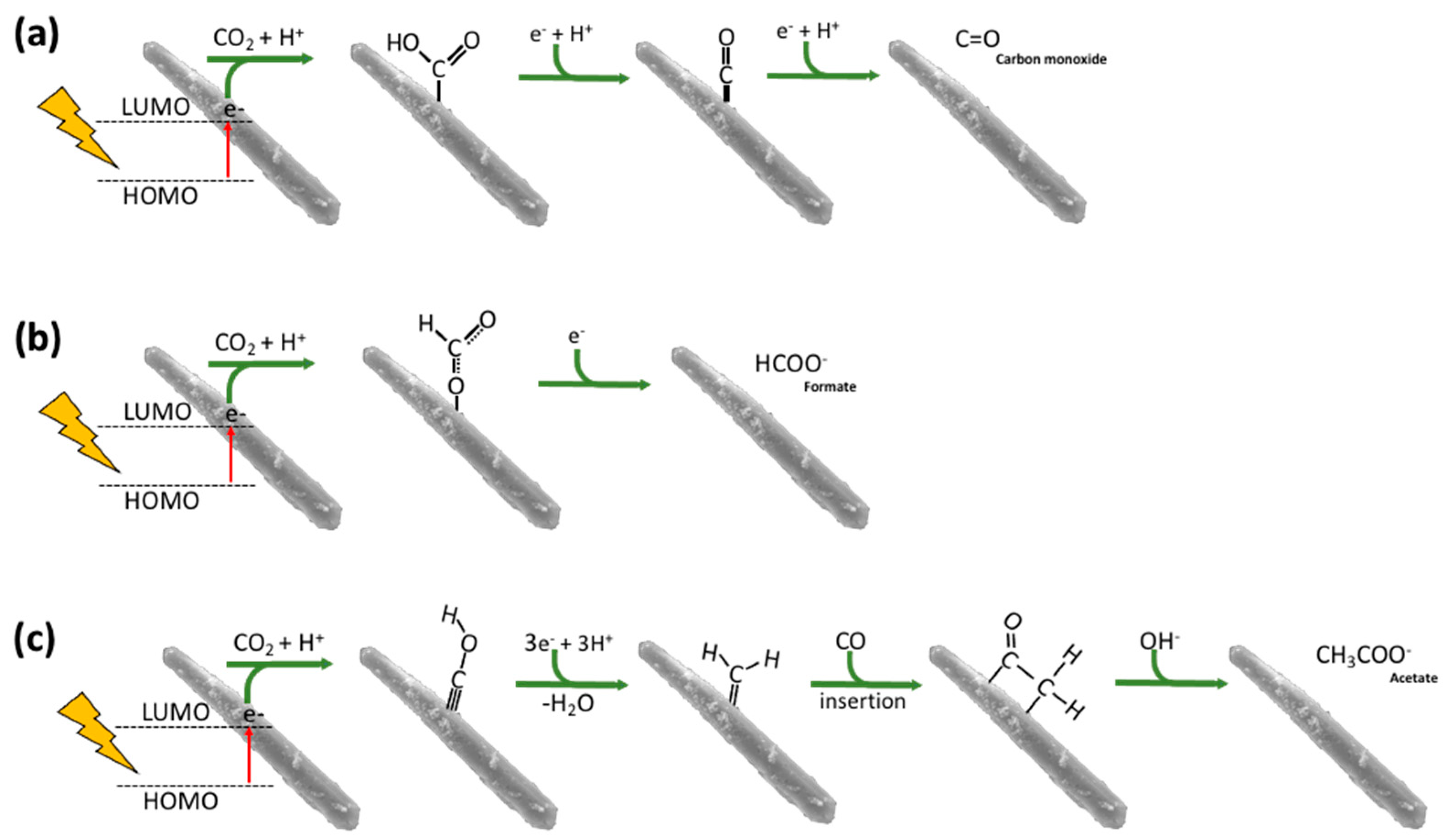The Facile Microwave-Assisted Coprecipitation Route to Obtain Polyoxoniobate (Na7(H3O)Nb6O19·14H2O) Nanorods Modified with Copper for CO2 Photoreduction
Abstract
1. Introduction
2. Materials and Methods
2.1. Synthesis of the Polyoxoniobate Pure and Modified with Copper
2.2. Characterization
2.3. Photoreduction Tests
3. Results and Discussion
3.1. Cu-PONs Structural Characterizations
3.2. CO2 Photoreduction
4. Conclusions
Supplementary Materials
Author Contributions
Funding
Conflicts of Interest
References
- Alsarhan, L.M.; Alayyar, A.S.; Alqahtani, N.B.; Khdary, N.H. Circular Carbon Economy (CCE): A Way to Invest CO2 and Protect the Environment, a Review. Sustainability 2021, 13, 11625. [Google Scholar] [CrossRef]
- Olah, G.A. Beyond Oil and Gas: The Methanol Economy. Angew. Chem. Int. Ed. Engl. 2005, 44, 2636–2639. [Google Scholar] [CrossRef] [PubMed]
- Torres, J.A.; Cruz, J.C.; Nogueira, A.E.; Silva, G.T.S.T.; Oliveira, J.A.; Ribeiro, C. Role of Cu0-TiO2 interaction in catalyst stability in CO2 photoreduction process. J. Environ. Chem. Eng. 2022, 10, 107291. [Google Scholar] [CrossRef]
- Rawat, K.S.; Mahata, A.; Pathak, B. Thermochemical and electrochemical CO2 reduction on octahedral Cu nanocluster: Role of solvent towards product selectivity. J. Catal. 2017, 349, 118–127. [Google Scholar] [CrossRef]
- Silva, G.; Lopes, O.; Dias, E.; Torres, J.; Nogueira, A.; Faustino, L.; Prado, F.; Patrocínio, A.; Ribeiro, C. Redução de CO2 em hidrocarbonetos e oxigenados: Fundamentos, estratégias e desafios. Quím. Nova 2021, 44, 963–981. [Google Scholar] [CrossRef]
- Sharma, D.; Sharma, R.; Chand, D.; Chaudhary, A. Nanocatalysts as potential candidates in transforming CO2 into valuable fuels and chemicals: A review. Environ. Nanotechnol. Monit. Manag. 2022, 18, 100671. [Google Scholar] [CrossRef]
- Liu, Q.; Wang, X. Polyoxometalate Clusters: Sub-nanometer Building Blocks for Construction of Advanced Materials. Matter 2020, 2, 816–841. [Google Scholar] [CrossRef]
- Zhang, M.; Li, H.; Zhang, J.; Lv, H.; Yang, G.Y. Research advances of light-driven hydrogen evolution using polyoxometalate-based catalysts. Chin. J. Catal. 2021, 42, 855–871. [Google Scholar] [CrossRef]
- Gu, J.; Chen, W.; Shan, G.-G.; Li, G.; Sun, C.; Wang, X.-L.; Su, Z. The roles of polyoxometalates in photocatalyticarbontion of carbono dioxide. Mater. Today Energy 2021, 21, 100760. [Google Scholar] [CrossRef]
- Aureliano, M.; Gumerova, N.I.; Sciortino, G.; Garribba, E.; Rompel, A.; Crans, D.C. Polyoxovanadates with emerging biomedical activities. Coord. Chem. Rev. 2021, 447, 214143. [Google Scholar] [CrossRef]
- Ross, N.; Nqakala, N.; Willenberg, S.; Sifuba, S.; Iwuoha, E. Electrochemical Properties of Polyoxometalate (H3PMo12O40)-Functionalized Graphitic Carbon Nitride (g-C3N4). Electrocatalysis 2019, 10, 392–398. [Google Scholar] [CrossRef]
- Hervé, G.; Tézé, A.; Contant, R. General Principles of The Synthesis of Polyoxometalates in Aqueous Solution. In Polyoxometalate Molecular Science; Borrás-Almenar, J.J., Coronado, E., Müller, A., Pope, M., Eds.; NATO Science Series; Springer: Dordrecht, The Netherlands, 2003; p. 98. [Google Scholar]
- Nyman, M. Polyoxoniobate chemistry in the 21st century. Dalton Trans. 2011, 40, 8049. [Google Scholar] [CrossRef]
- Niu, J.; Fu, X.; Zhao, J.; Li, S.; Ma, P.; Wang, J. Two-Dimensional Polyoxoniobates Constructed from Lindqvist-Type Hexaniobates Functionalized by Mixed Ligands. Cryst. Growth Des. 2010, 10, 3110–3119. [Google Scholar] [CrossRef]
- Botar, B.; Ellern, A.; Hermann, R.; Kogerler, P. Electronic control of spin coupling in keplerate-type polyoxomolybdates. Angew. Chem. Int. Ed. 2009, 48, 9080–9083. [Google Scholar] [CrossRef]
- Zhang, H.; Wang, T.; Chen, W. Polyoxometalate modified all-weather solar cells for energy harvesting. Electrochim. Acta 2020, 330, 135215. [Google Scholar] [CrossRef]
- Liu, Z.Y.; Lin, Y.D.; Hao-Yu; Chen, H.N.; Guo, Z.W.; Li, X.X.; Zheng, S.T. Recent advances in polyoxoniobate-catalyzed reactions. Tungsten 2022, 4, 81–98. [Google Scholar] [CrossRef]
- Shen, J.-Q.; Zhang, Y.; Zhang, Z.-M.; Li, Y.-G.; Gao, Y.-Q.; Wang, E.-B. Polyoxoniobate-based 3D framework materials with photocatalytic hydrogen evolution activity. Chem. Commun. 2014, 50, 6017–6019. [Google Scholar] [CrossRef]
- Huang, P.; Qin, C.; Su, Z.-M.; Xing, Y.; Wang, X.-L.; Shao, K.-Z.; Lan, Y.-Q.; Wang, E.-B. Self-Assembly and Photocatalytic Properties of Polyoxoniobates: {Nb24O72}, {Nb32O96}, and {K12Nb96O288} Clusters. J. Am. Chem. Soc. 2012, 134, 14004–14010. [Google Scholar] [CrossRef]
- Makuła, P.; Pacia, M.; Macyk, W. How To Correctly Determine the Band GatoEnergy of Modified Semiconductor Photocatalysts Based on UV–Vis Spectra. J. Phys. Chem. Lett. 2018, 9, 6814–6817. [Google Scholar] [CrossRef]
- Shen, L.; Xu, Y.Q.; Gao, Y.Z.; Cui, F.Y.; Hu, C.W. 3D extended polyoxoniobates/tantalates solid structure: Preparation, characterization and photocatalytic properties. J. Mol. Struct. 2009, 934, 37–43. [Google Scholar] [CrossRef]
- Heng, S.; Song, Q.; Liu, S.; Guo, H.; Pang, J.; Qu, X.; Bai, Y.; Li, L.; Dang, D. Construction of 2D polyoxoniobate/RGO heterojunction photocatalysts for the enhanced photodegradation of tetracycline. Appl. Surf. Sci. 2021, 553, 149505. [Google Scholar] [CrossRef]
- Nyman, M.; Alam, T.M.; Bonhomme, F.; Rodriguez, M.A.; Frazer, C.S.; Welk, M.E. Solid-state Structures and Solution Behavior of Alkali Salts of the [Nb6O19]8− Lindqvist Ion. J. Clust. Sci. 2006, 17, 197–219. [Google Scholar] [CrossRef]
- Xu, H.; Nyman, M.; Nenoff, T.M.; Navrotsky, A. Prototype sandia octahedral molecular sieve (SOMS) Na2Nb2O6.H2O: Synthesis, structure and thermodynamic stability. Chem. Mater. 2004, 16, 2034–2040. [Google Scholar] [CrossRef]
- Goiffon, A.; Philippot, E.; Maurin, M. Structure cristalline du niobate 7/6 de sodium (Na7)(H3O)Nb6O19.14 H2O. Rev. Chim. Miner. 1980, 17, 466–476. [Google Scholar]
- Ma, P.; Wang, G.; Chen, G.; Wang, J.; Niu, J. A new two-dimensional polyoxoniobate built by Lindqvist-type polyoxoanion and copper coordinated cations K2[Cu(H2O)6]{[Nb6O19][Cu(NH3)]2}·8H2O. J. Mol. Struct. 2011, 997, 126–130. [Google Scholar] [CrossRef]
- Quirino, M.R.; Lucena, G.R.; de Araújo, R.J.C.; da Silva, A.R.; de Melo, A.M.; dos Santos, I.M.G.; Gama, L. CuO and Ce-doped CuO Prepared by Microwave Hydrothermal Method in Photodegradation of Remazol Golden Yellow Dye. Mat. Res. 2023, 26, e20220300. [Google Scholar] [CrossRef]
- Küngas, R. Review electrochemical CO2 reduction for CO production: Comparison of low- and high-temperature electrolysis technologies. J. Electrochem. Soc. 2020, 167, 044508. [Google Scholar] [CrossRef]
- Du, Z.-Y.; Yu, Y.-Z.; Li, N.-F.; Xue, Y.-S.; Xu, L.-X.; Mei, H.; Xu, Y. Polyoxomet-alate-Induced ‘Cage-within-Cage’ Metal–Organic Frameworks with High Efficiency towards CO2 Photoreduction. Sustain. Energy Fuels 2021, 5, 3876. [Google Scholar] [CrossRef]
- Qiao, L.; Song, M.; Geng, A.; Yao, S. Polyoxometalate-Based High-Nuclear Cobalt–Vanadium–Oxo Cluster as Efficient Catalyst for Visible Light-Driven CO2 Reduction. Chin. Chem. Lett. 2019, 30, 1273–1276. [Google Scholar] [CrossRef]
- Du, Z.-Y.; Xue, Y.-N.; Liu, X.-M.; Li, N.-F.; Wang, J.-L.; Mei, H.; Xu, Y. An Unprecedented Polyoxometalate-Encapsulated Organo–Metallophosphate Framework as a Highly Efficient Cocatalyst for CO2 Photoreduction. J. Mat. Chem. A 2022, 10, 3469–3477. [Google Scholar] [CrossRef]
- Zhou, J.; Chen, W.; Sun, C.; Han, L.; Qin, C.; Chen, M.; Wang, X.; Wang, E.; Su, Z. Oxidative Polyoxometalates Modified Gra-phitic Carbon Nitride for Visible-Light CO2 Reduction. ACS Appl. Mater. Interfaces 2017, 9, 11689–11695. [Google Scholar] [CrossRef] [PubMed]
- Kildahl, H.; Wang, L.; Tong, L.; Cao, H.; Ding, Y. Industrial carbon monoxide production by thermochemical CO2 splitting—A techno-economic assessment. J. CO2 Util. 2022, 65, 102181. [Google Scholar] [CrossRef]
- Du, C.; Wang, X.; Chen, W.; Feng, S.; Wen, J.; Wu, Y.A. CO2 transformation to multicarbon products by photocatalysis and electrocatalysis. Mater. Today Adv. 2020, 6, 100071. [Google Scholar] [CrossRef]
- Dzade, N.Y. CO2 and H2O coadsorption and reaction on the low-index surfaces of tantalum nitride: A first-principles DFT-D3 investigation. Catalysts 2020, 10, 1217–1231. [Google Scholar] [CrossRef]
- Cao, Y.; Chen, Q.; Shen, C.; He, L. Polyoxometalate-Based Catalysts for CO2 Conversion. Molecules 2019, 24, 2069. [Google Scholar] [CrossRef] [PubMed]
- Xu, Q.; Niu, Y.; Wang, G.; Li, Y.; Zhao, Y.; Singh, V.; Niu, J.; Wang, J. Polyoxoniobates as a superior Lewis base efficiently catalyzed Knoevenagel condensation. Mol. Catal. 2018, 453, 93–99. [Google Scholar] [CrossRef]
- Ren, D.; Fong, J.; Yeo, B.S. The effects of currents and potentials on the selectivities of copper toward carbon dioxide electroreduction. Nat. Commun. 2018, 9, 925. [Google Scholar] [CrossRef]
- Ci, C.; Carbó, J.J.; Neumann, R.; Graaf, C.; Poblet, J.M. Photoreduction Mechanism of CO2 to CO Catalyzed by a Rhenium(I)−Polyoxometalate Hybrid Compound. ACS Catal. 2016, 6, 6422–6428. [Google Scholar] [CrossRef]
- Nogueira, A.E.; Silva, G.T.S.T.; Oliveira, J.A.; Lopes, O.F.; Torres, J.A.; Carmo, M.; Ribeiro, C. CuO Decoration Controls Nb2O5 Photocatalyst Selectivity in CO2 Reduction. ACS Appl. Ener. Mater. 2020, 3, 7629–7636. [Google Scholar] [CrossRef]
- Sakhno, Y.; Bertinetti, L.; Iafisco, M.; Tampieri, A.; Roveri, N.; Martra, G. Surface hydration and cationic sites of nanohydroxyapatites with amorphous or crystalline surfaces: A comparative study. J. Phys. Chem. C 2010, 114, 16640–16648. [Google Scholar] [CrossRef]
- Diallo-Garcia, S.; Osman, M.B.; Krafft, J.-M.; Casale, S.; Thomas, C.; Kubo, J.; Costentin, G. Identification of surface basic sites and acid–base pairs of hydroxyapatite. J. Phys. Chem. C 2014, 118, 12744–12757. [Google Scholar] [CrossRef]
- Chong, R.; Fan, Y.; Du, Y.; Liu, L.; Chang, Z.; Li, D. Hydroxyapatite decorated TiO2 as efficient photocatalyst for selective reduction of CO2 with H2O into CH4. Int. J. Hydrogen Energy 2018, 43, 22329–22339. [Google Scholar] [CrossRef]








| Materials | Band Gap (eV) | %Cu * |
|---|---|---|
| PON-150 °C/30 min | 3.36 | - |
| Cu-PON-150 °C/20 min | 2.60 | 6.99 |
| Cu-PON-80 °C/30 min | 3.40 | 10.05 |
| Cu-PON-100 °C/30 min | 3.30 | 10.65 |
| Cu-PON-150 °C/30 min | 3.20 | 11.76 |
| Materials | Length Particle Size (µm) * | Width Particle Size (µm) * | Aspect Ratio * |
|---|---|---|---|
| PON 150 °C/30 min | 7.33 ± 3.49 | 1.74 ± 0.55 | 4.20 |
| Cu-PON 150 °C/20 min | 5.43 ± 1.73 | 1.26 ± 0.36 | 4.31 |
| Cu-PON 80 °C/30 min | 9.09 ± 4.30 | 1.38 ± 0.43 | 6.58 |
| Cu-PON 100 °C/30 min | 6.06 ± 3.00 | 1.22 ± 0.46 | 4.97 |
| Cu-PON 150 °C/30 min | 5.04 ± 2.43 | 1.08 ± 0.36 | 4.67 |
| Photocatalyst | POM Composition | Medium | Radiation | CO Selectivity | Reference |
|---|---|---|---|---|---|
| Cu-modified polyoxoniobate | Na7(H3O)Nb6O19·14H2O | High-purity CO2 purged into deionized water | UV-radiation (254 nm) | 92.5% | This work |
| Mo-based MOF prepared via POM induction | Zn2Co2(MoO4)(HCO2)3(C4H5N2)3•DMF (Zn/Co/Mo MOF) | Gaseous pure CO2 medium with MeCN solvent, [Ru(bpy)3]Cl2 photosensitizer and TEOA sacrificial agent | Visible light | 91.4% | [29] |
| Mo-based MOF prepared via POM induction | Zn4(MoO4)(HCO2)3(C4H5N2)3•DMF (Zn/Mo MOF) | gaseous pure CO2 medium with MeCN solvent, [Ru(bpy)3]Cl2 photosensitizer and TEOA sacrificial agent | Visible light | 72.8% | [29] |
| The POM with composition K4Na28[{Co4(O-H)3(VO4)}4(SiW9O34)4] 66H2O | K4Na28[{Co4(O-H)3(VO4)}4(SiW9O34)4] 66H2O | The substrate was CO2 saturated in CH3CN/H2O as solvent. Using TEOA as sacrificial agent and [Ru(phen)3] as photosensitizer | 450 nm LED ligh | 99.6% | [30] |
| POM-based host– guest organo–metallophosphate (OMPO) frameworks | [Zn4(PO4)(C7H8N4)6] [BW12O40]•2H2O | High purity CO2 was the substrate. The CH3CN was the solvent. TEOA was the sacrificial agent, and [Ru(bpy)3]Cl2 was the photosensitizer | Visible light | 64.6% | [31] |
| POM-based host– guest organo–metallophosphate (OMPO) frameworks | [Co4(PO4)(C7H8N4)6] [BW12O40]•1.5H2O | High purity CO2 was the substrate. The CH3CN was the solvent. TEOA was the sacrificial agent, and [Ru(bpy)3]Cl2 was the photosensitizer | Visible light | 93.4% | [31] |
| g-C3N4 modified with POM | Na10Co4(H2O)2(PW9O34)2 | The substrate was pure CO2 purged in a mixture of acetonitrile, triethanolamine, CoCl2, and bipyridine solution | Visible radiation with wavelength > 420 nm | 94% | [32] |
Disclaimer/Publisher’s Note: The statements, opinions and data contained in all publications are solely those of the individual author(s) and contributor(s) and not of MDPI and/or the editor(s). MDPI and/or the editor(s) disclaim responsibility for any injury to people or property resulting from any ideas, methods, instructions or products referred to in the content. |
© 2023 by the authors. Licensee MDPI, Basel, Switzerland. This article is an open access article distributed under the terms and conditions of the Creative Commons Attribution (CC BY) license (https://creativecommons.org/licenses/by/4.0/).
Share and Cite
Souza, J.R.C.; Torres, J.A.; Ribeiro, L.S.; Filho, J.B.G.; Santos, F.L.; Malgioglio, N.; Gorup, L.F.; Pinto, A.H.; Nogueira, A.E. The Facile Microwave-Assisted Coprecipitation Route to Obtain Polyoxoniobate (Na7(H3O)Nb6O19·14H2O) Nanorods Modified with Copper for CO2 Photoreduction. AppliedChem 2023, 3, 320-333. https://doi.org/10.3390/appliedchem3020020
Souza JRC, Torres JA, Ribeiro LS, Filho JBG, Santos FL, Malgioglio N, Gorup LF, Pinto AH, Nogueira AE. The Facile Microwave-Assisted Coprecipitation Route to Obtain Polyoxoniobate (Na7(H3O)Nb6O19·14H2O) Nanorods Modified with Copper for CO2 Photoreduction. AppliedChem. 2023; 3(2):320-333. https://doi.org/10.3390/appliedchem3020020
Chicago/Turabian StyleSouza, Joelma R. C., Juliana A. Torres, Lucas S. Ribeiro, Jose B. G. Filho, Fabiana L. Santos, Nicholas Malgioglio, Luiz Fernando Gorup, Alexandre H. Pinto, and André E. Nogueira. 2023. "The Facile Microwave-Assisted Coprecipitation Route to Obtain Polyoxoniobate (Na7(H3O)Nb6O19·14H2O) Nanorods Modified with Copper for CO2 Photoreduction" AppliedChem 3, no. 2: 320-333. https://doi.org/10.3390/appliedchem3020020
APA StyleSouza, J. R. C., Torres, J. A., Ribeiro, L. S., Filho, J. B. G., Santos, F. L., Malgioglio, N., Gorup, L. F., Pinto, A. H., & Nogueira, A. E. (2023). The Facile Microwave-Assisted Coprecipitation Route to Obtain Polyoxoniobate (Na7(H3O)Nb6O19·14H2O) Nanorods Modified with Copper for CO2 Photoreduction. AppliedChem, 3(2), 320-333. https://doi.org/10.3390/appliedchem3020020







